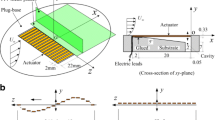Abstract
It is well known that the application of active flow-control strategies has the potential to increase the efficiency of many devices when compared to static actuator concepts. However, many aspects of the flow-control process are not well understood. In the case of pneumatic vortex generators the importance of coherent structures and their interaction with turbulent boundary layers remains an open question. A flat plate experiment was performed to determine the dynamic evolution of the induced vortex structures using phase-locked stereoscopic Particle Image Velocimetry. The qualification of the actuator system was performed by means of the time-resolved Particle Image Velocimetry measurements of the jet flow. The results show that an initial overshooting of the jet velocity dominates the unsteady start-up process, which results in a vortex structure of larger size and impact. This effect differs essentially from the case of steady blowing. In addition, the ability to shift high-momentum fluid into the near-wall region is a result of strong mixing combined with a minimum distance between the vortex core and the model surface.














Similar content being viewed by others
References
Bitter M, Ortmanns J, Kähler CJ (2006) Untersuchungen zur Dynamik künstlich angeregter Längswirbel in einer turbulenten Plattengrenzschicht mit Stereo-PIV. Fachtagung Lasermethoden in der Strömungsmesstechnik, 5–7 September
Compton DA, Johnston JP (1992) Streamwise vortex production by pitched and skewed jets in a turbulent boundary layer. AIAA J 30(3):640–647
Gad-el-Hak M (2000) Flow-control: passive, active, and reactive flow management. Cambridge University Press, London, p 448
Godard G, Stanislas M (2006) Control of a decelerating boundary layer. Part3: Optimization of round jets vortex generators. Aerosp Sci Technol 10:455–464
Godard G, Foucaut JM, Stanislas M (2006) Control of a decelerating boundary layer. Part2: Optimization of slotted jets vortex generators. Aerosp Sci Technol 10:394–400
Jeong J, Hussain F (1995) On the identification of a vortex. J Fluid Mech 285:69–94
Johari H, Rixon GS (2003) Effects of pulsing on a vortex generator jet. AIAA J 41(2):2309–2315
Johnston JP, Nishi M (1990) Vortex generator jets—means for flow separation control. AIAA J 28(6):989–994
Kostas J, Foucaut JM, Stanislas M (2007) The flow structure produced by pulsed-jet vortex generators in a turbulent boundary layer in an adverse pressure gradient. Flow Turbul Combust. doi:10.1007/s10494-007-9069-3
Lachmann GV (ed) (1961) Boundary layer and flow-control, vols 1 & 2. Pergamon Press, Oxford
Magill JC, McManus KR (2001) Exploring the feasibility of pulsed jet separation control for aircraft configurations. J Aircr 38(1), January, February
Margalit S, Greenblatt D, Seifert A, Wygnanski I (2005) Delta wing stall and roll control using segmented piezoelectric fluidic actuators. J Aircr 42(3):698–709
Melton LP, Yao C-S (2006) Active control of separation form flap of a supercritical airfoil. AIAA J 44(1)
Okamoto S, Honma N, Adachi A, Honami S (2006) Dynamic interaction of the longitudinal vortices by active vortex generators. AIAA 2006–3181, 3rd AIAA flow-control conference, 5–8 June, San Francisco
Ortmanns J, Kähler CJ (2004) Investigation of pulsed actuators for active flow-control using phase locked stereoscopic particle image velocimetry. 12th int symposium on application of laser techniques to fluid mechanics, Lisbon
Ortmanns J, Kähler CJ (2007) The effect of a single vortex generator jet on the characteristics of a turbulent boundary layer. Int J Heat Fluid Flow. doi:10.1016/j.ijheatfluidflow.2007.06.006
Scholz P, Ortmanns J, Kähler CJ, Radespiel R (2006) Influencing the mixing process in a turbulent boundary layer by pulsed jet actuators. Notes on numerical fluid mechanics and multidisciplinary design (NNFM). Springer, Heidelberg, pp 265–272
Seifert A, Bachar T, Koss D, Shepshelovich M, Wygnanski I (1993) Oscillatory blowing: a tool to delay boundary-layer separation. AIAA J 11:2052–2060
Seifert A, Darabi A, Wygnanski I (1996) Delay of airfoil stall by periodic excitation. J Aircr 33(4):691–698
Seifert A, Eliahu S, Greenblatt D (1998) Use of piezoelectric actuators for airfoil separation control. AIAA J Tech Notes 36(8):1535–1537
Suzuki T, Nagata M, Shizawa T, Honami S (1998) Optimal injection condition of a single pulsed vortex generator jet to promote the cross-stream mixing. Exp Therm Fluid Sci 17:139–146
Tilmann C, Langan KL, Betterton JG, Wilson MJ (2003) Characterization of pulsed vortex generator jets for active flow-control. AFRL-VA-WP-TP-2003-336, Wright-Patterson Air Force Base
Tinapp F, Nitsche W (1998) LDV-measurements on a high-lift configuration with separation control. Laser techniques applied to fluid mechanics, 9th international symposium, Lisbon
Truckenbrodt E (1968) Strömungsmechanik. Springer, Berlin
Vollmers H (2001) Detection of vortices and quantitative evaluation of their main parameters form experimental velocity data. Meas Sci Technol 12:1199–1207
Wendt BJ (2001) Initial circulation and peak vorticity behavior of vortices shed from airfoil vortex generators. NASA/CR-2001-211144
Zhang X (2000) An inclined rectangular jet in a turbulent boundary layer-vortex flow. Exp Fluids 28:344–354
Author information
Authors and Affiliations
Corresponding author
Rights and permissions
About this article
Cite this article
Ortmanns, J., Bitter, M. & Kähler, C.J. Dynamic vortex structures for flow-control applications. Exp Fluids 44, 397–408 (2008). https://doi.org/10.1007/s00348-007-0442-8
Received:
Revised:
Accepted:
Published:
Issue Date:
DOI: https://doi.org/10.1007/s00348-007-0442-8




